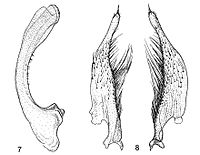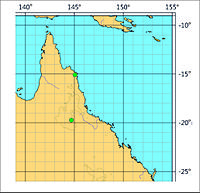Platynectes weiri
Taxonavigation
[edit]| Taxonavigation: Adephaga |
|---|
|
Superregnum: Eukaryota |
Familia: Dytiscidae
Subfamilia: Agabinae
Tribus: Hydrotrupini
Genus: Platynectes
Subgenus: Platynectes (Gueorguievtes)
Species: Platynectes weiri
Name
[edit]Platynectes weiri Hendrich & Šťastný, 2014
Type locality
[edit]White Mountain National Park, 20.27S 144.49E, 500 m, Queensland, Australia.
Type material
[edit]Holotype: ANIC. Male: “20.27S 144.49E QLD White Mountains N.P. 2.5 km NE of RGSQ/AG Base Camp 4 Apr. 2000 T. Weir at light”, “Holotype Platynectes weiri sp. n. Hendrich & Šťastný des. 2014” [red printed label] (ANIC). Paratypes (11 specimens): 3 males and 1 female with same data as holotype (ANIC, CLH); 2 males and 1 female: “20.26S 144.51E QLD White Mountains N.P. 2 km NE of RGSQ/AG Base Camp 5 – 7 Apr. 2000 T. Weir”, “Platynectes n. sp. C. Watts 2001” [hw], “Agabini genus? [hw] det. T.A. Weir 2001”, “deep rocky pool, cloudy, sandy bottom, vegetation, half shade“ (ANIC, CJS); 1 female: “20.27S 144.49E QLD Whishaw Station nr. Mountains N.P. 29 Mar. 2000 T. Weir”, “at light” (ANIC); 2 females: “15.16S 144.59E, 14 km WbyN Hope Vale Mission [69 m] QLD 7–10 May 1981 A. Calder”, “at light” (ANIC, CLH); 1 male: “QLD.: White Mountains 53 km NE Prairie, Sep 1995 D.J. Cook”, “Queensland Museum loan Date: Oct. 2006 No LE 06.23” [blue printed label] (QM). All paratypes provided with red printed paratype label.
Diagnosis
[edit]Medium-sized Platynectes, oval, rather flat, usually shiny, black with ten deep striae and few small yellow spots on elytron. Pronotum covered with two stripes of deep longitudinal striae (Fig. 1).
Description
[edit]Measurements: Holotype: TL = 8.2 mm, TL-H = 7.4 mm; width = 4.35 mm. Paratypes: TL = 7.4–8.6 mm, TL-H = 6.7–7.8 mm; width = 4.1–4.9 mm.
Head: black, dull, with one central rhombical yellow marking and two small spots not reaching anterior and posterior margin. Microreticulation absent. Reticulation strong, consisting of small meshes and of minute but deep punctures inside meshes. A posterior row of deeper grooves between eyes, and two larger and deeper clypeal grooves on disc and a shallow transverse depression beside eyes. Antennae reddish, long; antennomeres slender. Apical two antennomeres reaching elytron.
Pronotum: shiny, testaceous; anterior and posterior margins each with black broad stripe that fuse medially. Each stripe covered with several deep and well-marked longitudinal striae. Posterior angles of pronotum acute. Microreticulation absent. Reticulation discally strong, laterally shallow and almost invisible, consisting of strong and closed meshes without any punctures. Lateral margin, except in anterior fourth, almost completely bordered.
Elytron: black, shiny with five small yellow spots apically, three spots near shoulder, and a narrow yellowish one of variable length along posterior third of elytral margin. Elytron with 10 deep longitudinal striae of different length. Nine striae covering 4/5th of elytron, 10th and marginal striae only half of elytron. Sutural stripe of 9 to 10 deep and long strioles visible. Epipleura rufo-testaceous. Reticulation fine but visible at usual magnification (80×), consisting of closed meshes and of minute but deep punctures.
Ventral surface: rufo-piceus. Legs rufo-testaceous. Prosternal process broad, 2 times as long as broad, distinctly bordered at sides, and pointed out at apex. Metaventral wings very narrow. Metacoxal lines raised, well separated, a little divergent in anterior half. Metacoxal plate with few narrow scratches, microreticulation consisting of minute punctures. Abdominal ventrites 2, 4 and 6 laterally with a testaceous spot. Last ventrite narrowly microreticulate with minute punctures and with some strong oblique striations. Posterior margin bordered and broadly rounded.
Male: Protarsus little expanded, moderately clothed with setae ventrally. Aedeagus: Median lobe regularly curved in lateral view, broadened at apical half and rounded at apex (Fig. 2 - 7). Parameres narrow with long setae, more elongate (Fig. 2 - 8).
Sexual dimorphism: Females are similar to males, but pro- and mesotarsomeres 1–3 not dilated and without adhesive setae in female.
Variability: Specimens examined show variation in the body size and the extent of yellow color pattern on head.
Affinities
[edit]Platynectes weiri sp. n. is similar to P. ponderi sp. n. but can be easily separated by the presence of 10 striae on elytra instead of seven striae in P. ponderi sp. n., and the shape of the median lobe in aedeagus. Furthermore, the yellow markings on elytra are reduced to five small yellow spots apically, and three spots on shoulder.
Habitat
[edit]According to Weir (2003) the specimens in White Mountain National Park (2 km NE of RGSQ/AG Base Camp) were collected in a large deep pool, with rocky surrounds and only a little vegetation at the edge. It can be classed as a lentic habitat within a lentic zone as both experience flow during periods of rain. All the other specimens were collected at light.
Etymology
[edit]This species is dedicated to our Australian colleague Tom Weir (Canberra, Australia) who collected most of the type specimens and recognized the species as new. The specific epithet is a substantive in the genitive case.
Distribution
[edit](Fig. 3). Northern Queensland. Collected from two isolated spots 580 km from each other: White Mountain National Park in the inner part of northern Queensland and Hope Vale Mission near Cooktown in north-eastern Queensland.
Images
[edit]-
Figure 1. Platynectes weiri. (Photo: Michael Balke)
-
Figure 2. Median lobe and parameres of Platynectes weiri. (Drawing: Jaroslav Šťastný)
-
Figure 3. Distribution map of Platynectes weiri, Northern Queensland, Australia
References
[edit]- Hendrich, L. & Šťastný, J. 2014. Taxonomic revision of Australian Platynectes Régimbart, 1879 (part I)—four new species from Queensland (Coleoptera: Dytiscidae, Agabinae). Zootaxa 3795(1): 25–37. DOI: 10.11646/zootaxa.3795.1.3.
 . Reference page.
. Reference page.


